Search
To search for an exact match, type the word or phrase you want in quotation marks.
A*DESK has been offering since 2002 contents about criticism and contemporary art. A*DESK has become consolidated thanks to all those who have believed in the project, all those who have followed us, debating, participating and collaborating. Many people have collaborated with A*DESK, and continue to do so. Their efforts, knowledge and belief in the project are what make it grow internationally. At A*DESK we have also generated work for over one hundred professionals in culture, from small collaborations with reviews and classes, to more prolonged and intense collaborations.
At A*DESK we believe in the need for free and universal access to culture and knowledge. We want to carry on being independent, remaining open to more ideas and opinions. If you believe in A*DESK, we need your backing to be able to continue. You can now participate in the project by supporting it. You can choose how much you want to contribute to the project.
You can decide how much you want to bring to the project.

From Maartje Fliervoet
Dear Constanza,
Thanks so much for all of this information. I am looking forward to talking to you.
I thought I could send you the introduction to our upcoming publication. I think it says something about our way of collective reading and writing but also connects to notions of Cosmologies.
Best,
Maartje
An Introduction
The appearance of this publication is flexible, as is its multidirectionality. It is meant to be read by several readers simultaneously. This work can be folded in a multiplicity of shapes, making it a performative document that focuses on an embodied, collective reading. Part of our writings for this publication come from texts written between Spring 1399 and Spring 1400 for the Remote Archivist, by invitation of de Appel, Amsterdam. Other fragments were taken from performative readings that took place at Stroom, The Hague (1400, de Appel (1398) and PrintRoom, Rotterdam (1401, based upon a contribution to an anthology of performance scores by Notes On Hapticity Collective). The collaborative writing of these texts naturally demanded the three of us to gradually merge into one voice, a transformative I.
This changed in late 1400. We had started planning for a trip to Iran, to take place in Mehr 1401. The intention was to work on this book through the lens of traditional Iranian architecture. Yet, as events developed, each of us was confronted in a highly individual way with the possible implications of this journey. During our preparations, we realised we’d become personally involved with the borders we’d previously written about, albeit with more distance. In our minds, we increasingly embodied these boundaries and the violence they bestowed upon us. In the end, only one of us actually went. Being physically separated and not always being able to be in contact, we started writing each other secret letters testifying to our respective positions, sharing our fears, traumas and dreams. This brought us to a deeper understanding of our more private experiences, and eventually our collective writing came to embrace them all.
We see this publication as an object through which we want to question the practice of archiving. We focus on archiving as a s/State of mind, rather than on those spaces generally called “archives” and their objects in captivity. This state is a mode of thinking with which we are each challenged on a daily basis, the mode of sticking to “the familiar,” opposing change and “the unknown”. We think momentarily interrupting this mode is crucial. To do so, we depart not from physical archives, but from (fictional) stories surrounding certain traditional Iranian buildings, the Persian garden and in particular an entrance room called the hashti. We compare such historical architecture to public and private spaces of our time like museums and archives, airports, subways and urban apartments, focusing on power relations between bodies moving through such sites. Through this comparison, the tension and hierarchy between gender, class and sexual orientation is encountered and unfolded. In short, the practice of archiving to us becomes a tool to look at social relations.
As a consequence, the nature of the collectables or the architecture that contains them, are of less importance to us here than the power dynamics keeping them in place. Because in a way “to archive” is to exert power, to take control, retaining the collected as it once was, in a desire to freeze time, enforcing a process of inertia upon it. The archived is ‘taken care of’ to such a degree that one could even speak of a violent form of care, accommodating a longing for an imposed isolation. The same happens in architectural forms such as walled gardens, where nature is supposed to be kept in place. A tendency that is in stark contradiction to the universe, which is in constant transformation, far from being stagnated.
The practice of archiving can be aimed at any pile of material anywhere—from your home’s library, your closet, a paper trash bin to your phone’s photo database. The act of archiving is not reserved to those professionally called “archivists,” and practising the archival doesn’t even require the pile of things usually referred to as a “collection,” for the same mechanisms of inclusion, exclusion and conservation can be put to work on the level of many human activities and (inter)human relations. Archiving as a striving for stagnation and domination can equally be observed in how authoritative structures repress certain groups of people. Regimes have a tendency to strive for a freezing of time, an unnatural status quo.
In terms of duration, in our writing we have opted to link the desire for inertia to the circulation of water, and ‘leaky’ concepts or categorisations, transforming over time. The texts therefore touch upon resistance, movement, secrets and porosity. These subjects are paired with social, political and material boundaries, and to the sphere of traditional archival practices.
The uprising in Iran, starting in Shahrivar 1401 (mid-September 2022), has played a significant role in the coming-into-being of this publication. We want to dedicate it to all those who resist, in any possible way.
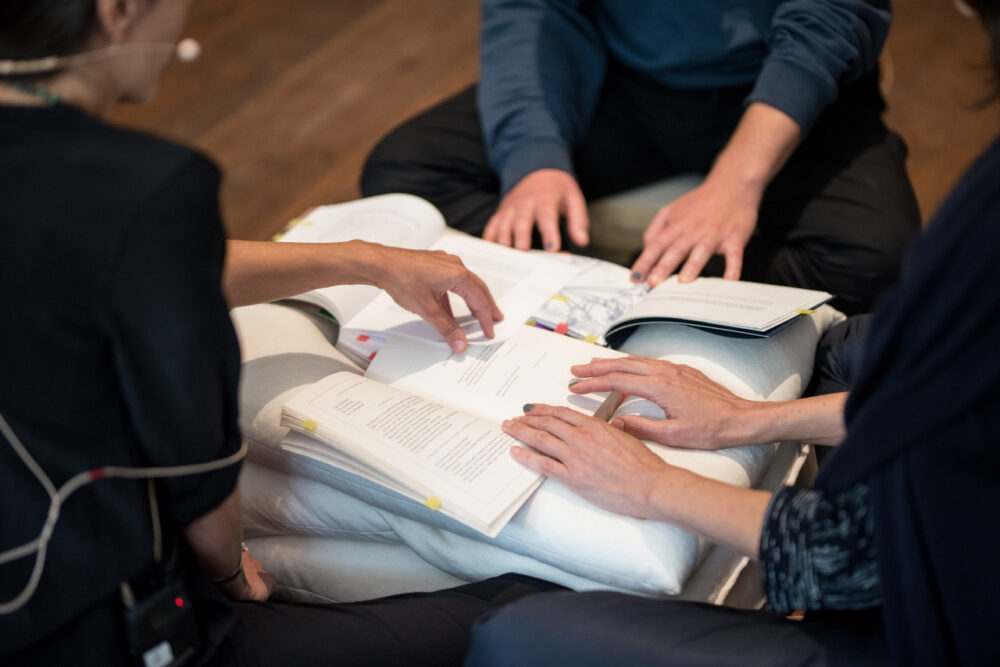
Triangular Reading, 2020 A research into Stroom’s archive, making and performative reading of two triangular book objects. “Uncertainty Seminar: care”, Stroom den Haag.

House of Secrets in Geometric Structures; study of the octagon in two dimensions. Fold on paper, Arefeh Riahi, 2021.
From Constanza Mendoza
Dear Arefeh, Maartje and Martin,
Yesterday was a real pleasure to talk with you. Unfortunately and to my huge regret I made a mistake with the recording by using the headphones to avoid the noise of the renovation of the facade of my building and only my voice was recorded. I apologize for this mistake. I also think that in many ways, yesterday’s conversation and your practice addressed this kind of issues.
I think it is not now a matter of trying to reproduce the conversation again but it could be more interesting that we explicitly cover this mistake as an example of these questions that you work on so carefully.
Best,
Constanza
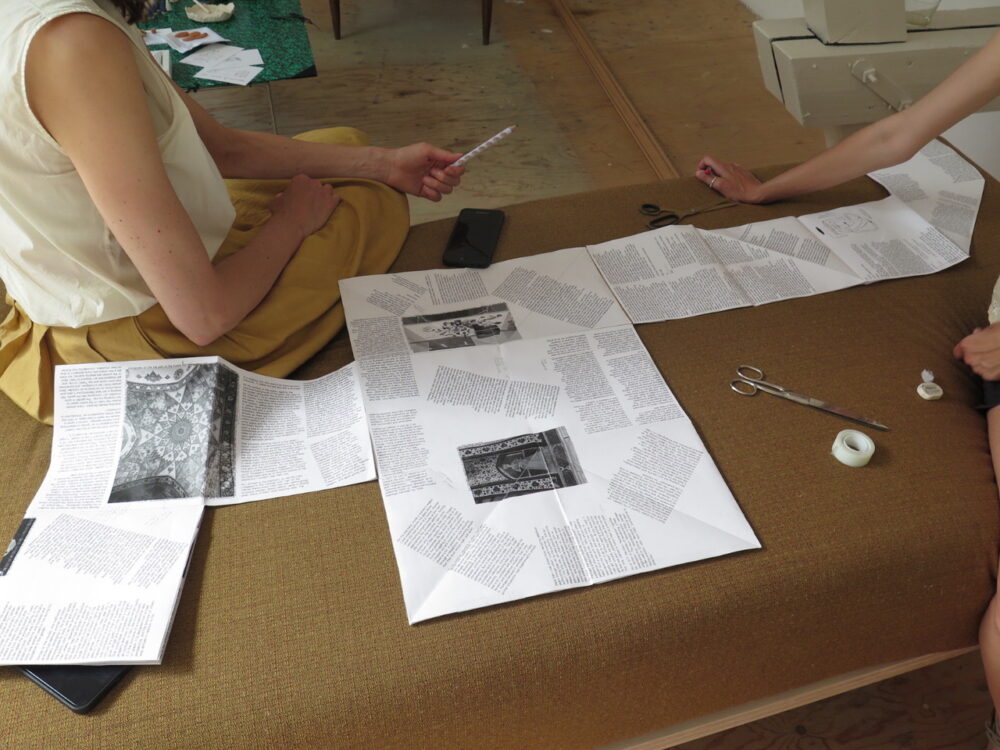
My Garden’s Boundaries Are the Horizon, 2023. Preparatory readings that were part of this multidirectional book design process. Design by Elisabeth Klement.
From Arefeh Riahi
Dear Constanza,
I also think that we shouldn’t be worried about the problem with recording. In fact I see it as an anarchival coincidence. Perhaps an interview with To See The Inability to See couldn’t be more accurate than this.
It reminds me of another similar incident that happened to us in our first collaboration. During my residency in De Appel, I gathered the discarded material of the archive for about two months, then I invited Martín and Maartje to work with me on them. Through this material which we considered “the outsider” we wanted to re-read what remained inside the archive. More often our meetings in the archive would begin with a personal story. It was then, the beginning of the Estallido Social, the Chilean protests, and Martín’s stories reminded me a lot of the Green Movement of 2009 in Iran. Our emotional stories would lead to political, philosophical, artistic and anarchivistic narrative/threads that would take us to different corners of the archive. And revealed what was hidden, what we couldn’t see.
In this process, one of the assignments that we gave ourselves was that each of us take home a bunch, from the pile of discarded material, and study, select and work on them and bring them back in two weeks. I worked on my share of the material, but the night before our next meeting, as I was bringing them home from my studio, so that I could take them to the archive the next day, I lost them in the tram! The next day, our conversation began with this personal story of loss. Here is a fragment from the publication 16/10/20 A project by Notes on Hapticity Collective, in which we wrote further about the incident:
“When I got home in the evening, I tried to rebuild a new version of the lost material for as far as I could remember. Yet I could recognize in me the desire for having the actual material back: that strange two-fold feeling when you value something more knowing that it’s lost. Having lost my ‘homework’, I felt like a bad student. In order to distract myself from the feeling of guilt, I took the Book of Anarchiving and came upon this passage: “The Anarchive resists the object, the it, the deliverable. […] this it… carves out space and time, makes cuts in the wave field/function, and momentarily articulates something out of chaos. Nothing is lost. It is all there and nowhere at the same time.” [1] The go-to, How To Book of Anarchiving. Edited by Andrew Murphie. Montreal, December 2016. Deliverable by Thea Patterson.
You see, this is our perfect interview.
We see the archive as a state of mind, as a mode of thinking, and we want to break that mode and interrupt it, even momentarily. so that we could find new relations between things. So, what is happening here is basically towards our mission.
Towards remembering, I recall we talked about our different perspectives and positions in relation to the idea of a trip to Iran. The idea that brought our collaboration to an emotional and critical (in a good way) moment. We actually faced the borders that we were writing and thinking about for some time. We ourselves became the borders. In fact, not being able to go on that trip, was actually what pushed the boundaries of thinking and introduced us to other realities. We started to use our imagination, to resist the imposed boundaries. Our collective imagination pierced the borders and we took a ‘fictional’ trip to Iran, to begin a conversation that has already begun, but this time around a pool in an open “hashti” in the middle of a walled garden. Like I wrote in our multi-directional publication: we arrived at this location, while weaving thoughts on water, gardens and architecture.
I was the only one who physically made it there. But I was metaphysically carrying the gazes of the other two. They became my secret companions and I saw, thought and experienced things with them. I became a collective, which is amazing when I think about it now, because in our collective we always look for ways to break the singular mode of reading and writing, in search of new interpretation and understanding. The capitalist structures that we are living in, pushes us towards individualism. In fact, the biggest problem in Iran, during Jina’s uprising, was that it was very difficult for people to get together in large numbers. A crowd is what the government prevents with all its power. What seems impossible is organising a group of people to do something together. I think a similar force exists here too. It is just not operating in a very obvious way like anti-riot police forces in Iran. it rather operates in our minds.
I just add one more sentence:
Collective thinking is a resistance.
Let’s continue this conversation.
Best wishes,
Arefeh
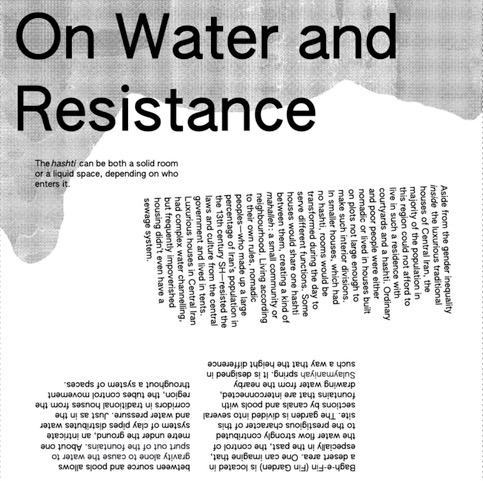
My Garden’s Boundaries Are the Horizon, 2023. A dummy of the design process that shows leakages coming into the text as part of the On Water and Resistance Chapter. Leakages by Maartje Fliervoet, design by Elisabeth Klement.
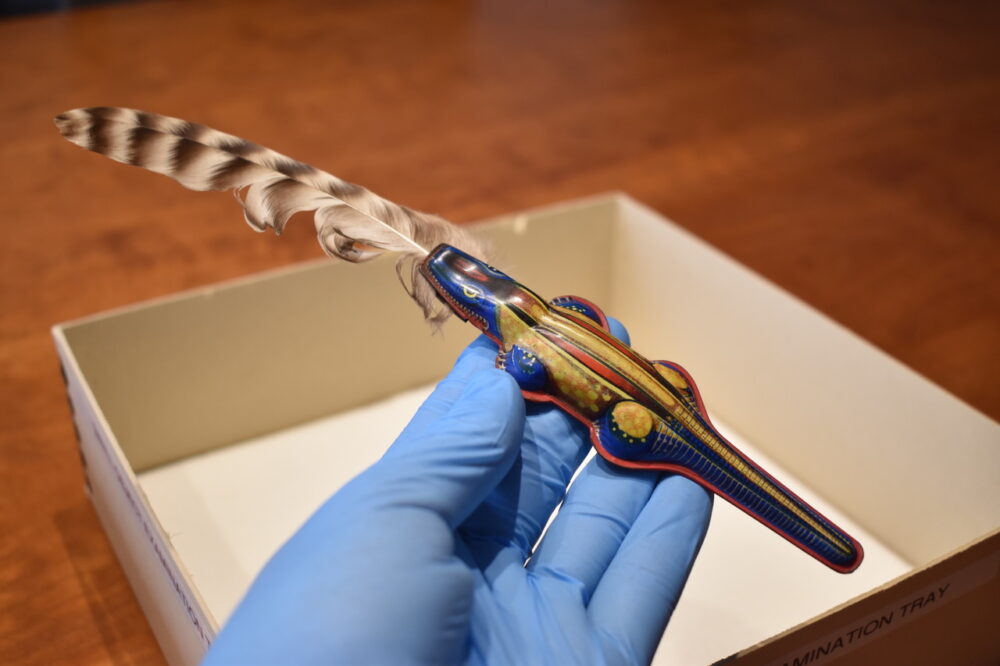
Item from the Magic Box (092.2.0547, Box 116), within the David Wojnarowicz Papers, at the Fales Library & Special Collections, New York University. Photo by Martín La Roche.
From Martín La Roche
Dear Constanza, Arefeh and Maartje,
‘Nothing is lost’
I have to think of the moment in which Arefeh missed her part of the archive. I feel similar, shredding everything apart. It also reminds me of Rod Summers, who we wrote about in the Remote Archivist, and how in 1978 he shredded apart one entire year of activities in the international mail art system as part of a performance in de Appel.
I remember from our very special unrecorded conversation/interview, that we also talked about how much these circles have become more intimate and personal. We started out from a merged voice that was very concerned with public, social and artistic topics, a voice that tried to have an overview of the archive and its mechanisms, and ended up with a multiplicity of voices. In our preparations for the trip to Iran, as a group, our bodies confronted certain boundaries, and that pivoted our writing to a more intimate, personal and situated writing. In the meantime, the movement ز ، ن ز ندگی ، آز اد ی (in Farsi), Zan Zendegui Azadi, Woman Life Freedom, changed everything, including us. Maybe because of this, a political dimension has been stressed in our narration, a view coming from within the garden, looking inside the house, thinking of its partitions. This is not without saying that our search is always poetic and has different scales. Like the mine tailings that connect Maartje’s practice to you, Constanza. Cosmologies heading to cosmopoetics passing always through cosmopolitics.
Welterusten
Slaap lekker
Martin
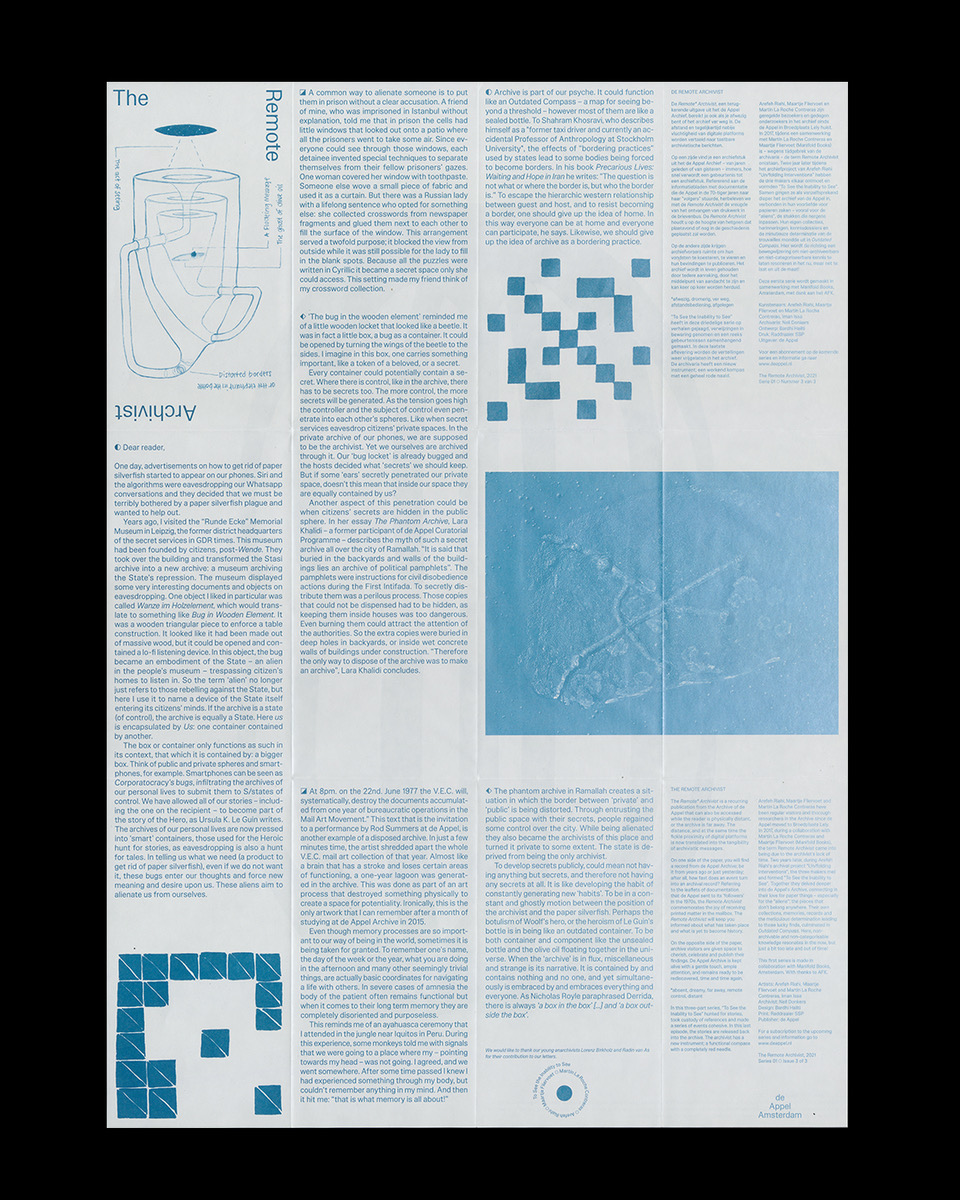
The Remote Archivist #1 & #3, 2020-2021. Contribution to newsletter, of the archive of de Appel focusing on power relations in archives and mechanisms of exclusion. Distributed by de Appel and Metropolis M.
—————————————————————————————-
We chose the epistolary form that resulted from the fact that due to a technical error our initial conversation was not recorded. Through the personal “you” we evoke this “mistake” that led to an affection and a deeper exchange about the collective relationship of “To See The Inability To See”.
| ↑1 | The go-to, How To Book of Anarchiving. Edited by Andrew Murphie. Montreal, December 2016. Deliverable by Thea Patterson. |
|---|

To See The Inability To See
Maartje Fliervoet is a visual artist who lives and works in Amsterdam. Exploring photography, printmaking, installation, textile, language and printed matter, she aims to make space for the undefined, and formlessness as a way of thinking. In 2015 she initiated Manifold Books (@manifoldbooks), a project space that looks into relations between book space and exhibition space. A selection of spaces her work has been shown in: Institut de Carton (Brussels), Wiels CAC (Brussels), Kunstverein Göttingen (Göttingen), Grimmuseum (Berlin), Lokaal 01 Antwerp (Antwerp), Kunsthal Ghent (Ghent), de Appel (Amsterdam), Rozenstraat (Amsterdam) and Kunstverein (Amsterdam). She has participated in many residencies, including Het Pompgemaal (2018/19), the Frans Masereel Centre (2016, 2020), Air Berlin Alexanderplatz (2013), Lokaal 01 Antwerp (2011) and Wiels CAC (2010).
Arefeh Riahi (1979, Tehran) is a visual artist and researcher based in The Hague. Her writings, performances, videos, installations, drawings and paintings take up questions of archiving and anarchiving, body and space potentialities, relation to power, censorship, translatability, and the multiplicity of interpretation. Her work has been exhibited, among other, at ACC Galerie Weimar (Weimar) the W139 Project space (Amsterdam). de Appel (Amsterdam), Rozenstraat (Amsterdam), REDCAT; Roy and Edna Disney/CalArts Theater (Los Angeles, CA), The Peace Palace; The International Court of Justice (The Hague), Gemak (The Hague), 1646 Project Space (The Hague), Pratt Institute (Brooklyn), the 13th Delhi Photo Festival (India), Gallery Isabelle Van den Eynde (Dubai), Cinema Museum (Tehran). She is a graduate of the Azad University, Tehran, and Koninklijke Academie van Beeldende Kunsten, Den Haag.
Martín La Roche (b. Santiago de Chile, 1988, lives and works in Amsterdam) could be defined as a gatherer and storyteller. His interest in devices that can contain and transport objects and their memories has led him to the creation of portable collections and open books. His work has been shown in solo exhibitions, among others, at MAVI (Museum of Visual Arts, Santiago de Chile); Casanova (Sao Paulo, Brazil); Manifold books (Amsterdam, The Netherlands); Die Ecke Arte Contemporaneo, (Santiago de Chile / Barcelona, Catalunya), Miriam Gallery (Brooklyn, New York); and in group exhibitions in Colombia, Belgium, Serbia, Switzerland, Japan, China, among others.
In 2019, the three of them founded the writing collective To See the Inability to See.
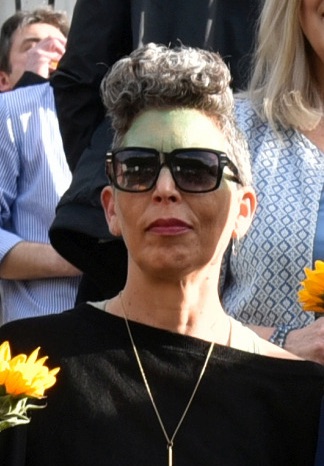
Constanza Mendoza (Chuquicamata, 1971) Visual artist and researcher based in Berlin. Through multimodal and multisited collective practices, my research responds to the need to overcome the disciplinary structures of the division of labor and the subjugation of subjectivity to the control of capital. In this context, artistic practices serve me as processes for acquiring and producing knowledge, while allowing me to cross the margins of the regime of truth that imposes servitude to the ideology of capital.
"A desk is a dangerous place from which to watch the world" (John Le Carré)